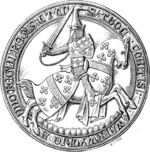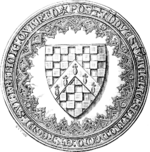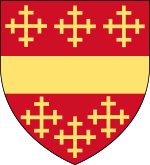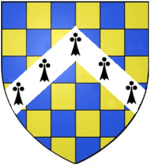Thomas Beauchamp, 11th Earl of Warwick facts for kids
Quick facts for kids
Thomas de Beauchamp
|
|
|---|---|
| Earl of Warwick | |
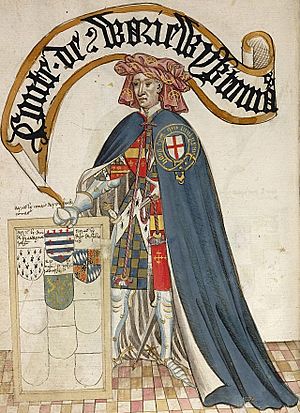
Thomas de Beauchamp, 11th Earl of Warwick, a founder knight of the Order of the Garter, wearing his special robes.
|
|
| Noble family | Beauchamp |
| Spouse(s) | Katherine Mortimer |
| Issue See details |
Thomas de Beauchamp, 12th Earl of Warwick William de Beauchamp, 1st Baron Bergavenny Philippa de Beauchamp, Countess of Stafford |
| Father | Guy de Beauchamp, 10th Earl of Warwick |
| Mother | Alice de Toeni |
Thomas de Beauchamp, 11th Earl of Warwick (born around February 14, 1313 – died November 13, 1369), was an important English nobleman and a strong military leader. He played a big part in the Hundred Years' War between England and France. The French even called him 'the devil Warwick' because he was such a feared fighter!
In 1348, Thomas became one of the first members of the Order of the Garter. This was a special group of knights created by King Edward III.
Thomas was known for his bravery in battle and his excellent leadership skills. For example, an old record from the 1300s says that when the Duke of Burgundy heard Thomas had landed nearby, he quickly retreated in the dark to avoid fighting him.
Thomas fought in Scotland when he was 24, leading an army against the Scots in 1337. He also fought in the Hundred Years' War against France, helping England win the famous Battle of Crécy in 1346.
Contents
Early Life and Important Roles
Thomas de Beauchamp was born at Warwick Castle in Warwickshire. His parents were Guy de Beauchamp, 10th Earl of Warwick and Alice de Toeni.
He spent a lot of time fighting in Scotland during the 1330s. He was the captain of the army against the Scots in 1337. Thomas also held important positions in England. He was the main sheriff for Worcestershire from 1333 until he died. In 1344, he also became the main sheriff for Warwickshire and Leicestershire for the rest of his life.
Victories at Crécy and Poitiers
Thomas de Beauchamp was the Earl Marshal of England from 1343 or 1344 until 1369. This meant he was a very high-ranking officer in the army. He was one of the main commanders in two huge English victories: the Battle of Crécy and the Battle of Poitiers (1356). He also took part in the Siege of Calais (1346).
He fought in all of King Edward III's wars against France. At the Battle of Crécy, he led the center of the English army. Many of his relatives died in this battle, including his younger half-brother. King Edward III trusted Thomas so much that he made him the guardian of his sixteen-year-old son, the Black Prince.
Thomas started rebuilding the Collegiate Church of Saint Mary in Warwick. It's often said he used money from the ransom of the Archbishop of Sens, whom he captured at Poitiers. However, the real story is a bit more complex than that.
Family Life
Thomas de Beauchamp married Katherine Mortimer. She was the daughter of Roger Mortimer, 1st Earl of March.
They had a large family with five sons and ten daughters:
- Guy de Beauchamp (died 1360).
- Thomas de Beauchamp, 12th Earl of Warwick (1339–1401), who became the next Earl of Warwick.
- Reinbrun de Beauchamp (died 1361).
- William de Beauchamp, 1st Baron Bergavenny (around 1343–1411).
- Roger de Beauchamp (died 1361).
- Maud de Beauchamp (died 1403), who married Roger de Clifford, 5th Baron de Clifford.
- Philippa de Beauchamp, who married Hugh de Stafford, 2nd Earl of Stafford.
- Alice Beauchamp (died 1383).
- Joan de Beauchamp.
- Isabel de Beauchamp (died 1416).
- Margaret de Beauchamp.
- Elizabeth de Beauchamp.
- Anne de Beauchamp.
- Juliana de Beauchamp.
- Katherine de Beauchamp, who became a nun.
Death
Thomas's wife, Katherine, passed away on August 4, 1369. Thomas de Beauchamp himself died three months later, on November 13, 1369, in Calais. He was 56 years old and died from the Black Death. He was buried next to his wife in St. Mary's Church in Warwick.
Images for kids
| Peerage of England | ||
|---|---|---|
| Preceded by Guy de Beauchamp |
Earl of Warwick 1329–1369 |
Succeeded by Thomas de Beauchamp |



